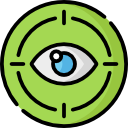DIAGNOSTICS
VISUAL FIELD ASSESSMENT

VISUAL FIELD ASSESSMENT

FLUORESCEIN ANGIOGRAPHY
FLUORESCEIN ANGIOGRAPHY

OCT SCANNING
OCT SCANNING

FUNDUS PHOTOGRAPHY
FUNDUS PHOTOGRAPHY

CORNEAL TOPOGRAPHY
CORNEAL TOPOGRAPHY

BIOMETRY
BIOMETRY
VISUAL FIELD ASSESSMENT
We normally see a wide area of the space in front of us. Without moving our eyes, we see not only what is straight ahead, but some of what is above, below, and off to either side. Most people are familiar with this as “peripheral vision.” The entire area that we see is called the visual field.
Vision is usually best right in the middle of the visual field. That is why we turn our eyes toward objects that we want to see better. The farther away from the center of our vision an object is, the less clearly we can see it. When an object moves far enough to the side, it disappears from our vision completely.
A visual field test measures two things:
- How far up, down, left and right the eye sees without moving.
- How sensitive the vision is in different parts of the visual field.
Why do people need a visual field test?
The visual field test can help the doctor find early signs of diseases like glaucoma that damage vision gradually. Some people with glaucoma do not notice any problems with their vision, but the visual field test shows that peripheral vision is being lost.
A visual field test can also help the doctor find out more about the part of the nervous system that allows us to see. The visual part of the nervous system includes the retina (the “film” in the camera-like eye), the optic nerve (the “wire” that carries images from the retina to the brain), and the brain itself. Problems with any part of this system can change the visual field. There are well-known patterns in the test results that help doctors recognize certain types of injury or disease. By repeating more visual field tests at regular intervals, doctors can also tell whether the patient is getting better or worse.
What happens during a visual field test?
There are several types of visual field tests, but they all have one thing in common: the patient looks straight ahead at one point and signals when an object or a light is seen somewhere off to the side.
If the patient turns the eye to look directly at the object or the light, only the very center of the visual field will be tested. The tester will explain to the patient exactly where to look so that the test is accurate.
The two most basic types of visual field tests are very simple:
- Amsler grid: The Amsler grid is a pattern of straight lines that make perfect squares. The patient looks at a large dot in the middle of the grid and describes any areas where the lines look blurry, wavy, or broken. The Amsler grid is a quick test that measures only the middle of the visual field and provides your doctor with only a small amount of information.
- Confrontation visual field: The term “confrontation” in this test just means that the person giving the test sits facing the patient, about 3 or 4 feet away. The tester holds his or her arms straight out to the sides. The patient looks straight ahead, and the tester moves one hand or the other inward. The patient gives a signal as soon as the hand is seen.
The confrontation visual field test measures only the outer edge of the visual field, and it is not very exact.
What kind of test does the doctor order for more detailed information?
Computerized instruments are available to perform visual field tests and calculate results. These instruments give more reproducible and accurate results because:
The head is always in the same place during the test.
The instrument has a large central “target” for the patient to look at, so the center of the visual field can be kept steady.
The instrument uses tiny spots of light to test vision, and the brightness and color of the light can be changed to measure the sensitivity of vision at each location.
The tests have been given to thousands of healthy people, so the “normal” results are fairly well known. The instrument can compare each new test to these standards.
What do the results of the visual field test mean?
A “normal” visual field test means that the patient can see about as well as anyone else does in the center and around the edges of the visual field.
A test that shows visual field loss means that vision in some areas is not as sensitive as normal. It could be just a little vision loss in a small area or all vision lost in large areas.
The amount of vision loss and the areas affected are measured by the visual field test. These results are printed out by the instrument as patterns of dots or numbers. The patterns tell the doctor a lot about how the eye and the visual field system are working. This helps your doctor decide whether you have a health problem that needs additional testing to be diagnosed or if treatment is recommended.
Why do some people need to have visual field tests many times?
Sometimes the doctor will want to repeat the visual field test right away to make sure the results are accurate. If the patient is tired, for example, the test results can be unreliable.
Your doctor might also recommend that a visual field test is taken again in a few weeks, a few months, or a year. This might be necessary to make sure that no new problems are detected. When a condition like glaucoma is found, visual field tests are performed regularly to find out how well the treatment is working.
Visual field tests are especially important in the treatment of glaucoma. These tests will tell the doctor if vision is being lost even before the patient notices. That is just one of the reasons why people who have glaucoma need to keep all their appointments with their doctor.

